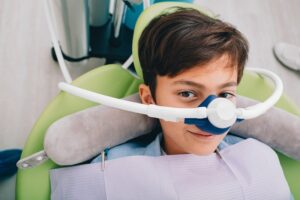
If your child has an intellectual or physical disability and finds dental visits stressful, it can be difficult to stick to the biannual checkup recommendation. You know professional cleanings and screenings are important, and you know your child would benefit from some accommodation. But maybe you don’t know what services to look for, or which ones are safe.
Fortunately, your pediatric dentist can help you find a solution. Laughing gas is one effective and reliable possibility that’s worth diving into. Keep reading to find out if this dental sedation option is right for your child.
How Can Laughing Gas Accommodate My Child with Special Needs?
Laughing gas could be an excellent option for young patients who:
- Experience anxiety or fear. Whether your child is diagnosed with generalized anxiety or has a more specific phobia, laughing gas can help them feel calm.
- Are sensitive to certain stimuli. Laughing gas can make sensory information less overwhelming. If your child doesn’t like loud noises, bright lights, or certain textures, they could benefit from this service.
- Are uncomfortable while sitting still. Some children experience general discomfort while sitting still. Laughing gas can help them stay still, ensuring quicker and more comfortable treatment.
Don’t think of this as an exhaustive list. Instead, keep in mind that laughing gas is an effective service for patients that normally find dental visits unpleasant. Many people appreciate how it can turn a distressing checkup into a positive experience.
What Exactly is Laughing Gas – What Does it Do?
Laughing gas is sometimes referred to as “nitrous oxide” or “nitrous oxide sedation” by dentists. Nitrous oxide is what gives laughing gas a sedative quality, but it’s diluted with oxygen to make it both safe and easy to adjust.
It is technically a sedative, but laughing gas won’t knock your child out. Instead, it relaxes muscles, calms nerves, and numbs pain. Many patients describe this gas as having a euphoric effect, so you can take comfort in knowing that it’s not painful or disturbing.
How Does Laughing Gas Work – Is it Safe?
First, your pediatric dentist will meet with you to review your child’s medical history. If they determine that nitrous oxide is the best choice for them, they’ll place a mask over your child’s nose. The mask is small and minimally invasive, but it does have to stay in place during treatment. An aid might hold the mask still, or it might have a strap so it can be fitted snuggly.
Laughing gas itself is odorless and colorless. However, to ensure the upmost safety, the machine that administers the gas has several security features. Plus, your pediatric dentist and their team will be monitoring your little one throughout their treatment. Should anything need to be adjusted, it can be done in seconds.
Overall, professionals agree that nitrous oxide sedation is safe and easy to regulate in-office. They find it an effective way to help many children feel more comfortable in the patient chair. If you think this sedation dentistry option could benefit your child, consult with your dentist. Together, you can give them a comfortable and welcoming visit.
About the Author
Dr. Natalie Gardner makes it her mission to help young patients feel relaxed, comfortable, and cared for. As a pediatric dentist, she has specialized training in caring for children with all manner of physical or intellectual disabilities and is proud to offer nitrous oxide for kids. If you want help creating a treatment plan for your child or have questions about accommodations, contact her office at 267-481-7707. For more information, explore her website.
